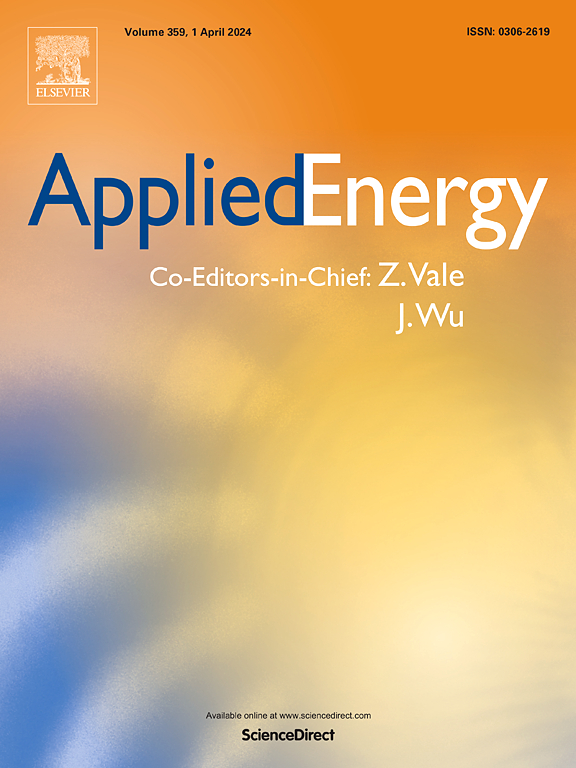A non-intrusive load monitoring-enabled framework for load scheduling in the dairy industry
IF 10.1
1区 工程技术
Q1 ENERGY & FUELS
引用次数: 0
Abstract
The agricultural industry is an important contributor to CO2 emissions, with dairy accounting for over 15 % of total agricultural output in the United Kingdom (UK). In line with the United Nations’ Sustainable Development Goals for responsible consumption, and affordable and clean energy, decarbonisation of agriculture is being prioritised around the world, with integration of renewables, energy storage systems, and load flexibility widely recognised as viable solutions to achieve net-zero. Analysis and optimisation of energy-consuming agri-processes remains a huge challenge — compared to residential and commercial buildings — due to non-standardised equipment and the emergence of on-site renewables. In contrast to previous studies that are narrow-focused, do not involve end-users, do not consider the diverse and largely varying day-to-day energy-intensive activities, or are not applicable at scale, this article proposes a novel, deep learning-based, data-driven, modular non-intrusive load monitoring (NILM)-enabled approach, where context is set through co-creation with farms and agritech. The proposed approach enables accurate and scalable load disaggregation at very-low frequencies (30-min), through transfer learning, and scheduling of energy-consuming processes, which minimises, simultaneously, total electricity import and carbon footprint, based on renewable production prediction, and granular regional carbon footprint forecasting. Findings from three small to medium/large-scale dairy farms in the UK with renewables and diverse non-standardised dairy equipment demonstrated that through the completely non-intrusive and scalable co-created load scheduling approach based on identified flexible loads, utility is preserved under a very-low frequency (30-min) disaggregation scenario. The proposed system achieves electricity cost and carbon footprint reduction of over 30 % compared to current energy practices on the three farms, and paves the way for completely non-intrusive/no capital investment NILM-enabled systems for the agriculture industry.
一个非侵入式负载监控框架,用于 乳品行业的负载调度
农业是二氧化碳排放的重要贡献者,乳制品占英国农业总产量的15% %以上。根据联合国关于负责任消费、负担得起的清洁能源的可持续发展目标,农业脱碳正在全球范围内得到优先考虑,可再生能源、储能系统和负荷灵活性的整合被广泛认为是实现净零排放的可行解决方案。由于非标准化设备和现场可再生能源的出现,与住宅和商业建筑相比,分析和优化能耗农业过程仍然是一个巨大的挑战。与以前的研究相比,这些研究的重点很窄,不涉及最终用户,不考虑多样化和很大程度上变化的日常能源密集型活动,或者不适用大规模,本文提出了一种新颖的,基于深度学习的,数据驱动的,模块化的非侵入性负载监测(NILM)启用方法,其中通过与农场和农业技术共同创造来设置上下文。所提出的方法通过迁移学习和能源消耗过程的调度,可以在非常低的频率(30分钟)下实现准确和可扩展的负载分解,从而根据可再生能源生产预测和颗粒区域碳足迹预测,同时最大限度地减少总电力进口和碳足迹。来自英国三个拥有可再生能源和各种非标准化乳制品设备的小型到中型/大型奶牛场的研究结果表明,通过基于确定的灵活负载的完全非侵入性和可扩展的共同创建负载调度方法,公用事业在极低频率(30分钟)分解情景下保持不变。与三个农场目前的能源实践相比,拟议的系统实现了电力成本和碳足迹减少30% %以上,并为农业行业完全非侵入性/无资本投资的nilm系统铺平了道路。
本文章由计算机程序翻译,如有差异,请以英文原文为准。
求助全文
约1分钟内获得全文
求助全文
来源期刊

Applied Energy
工程技术-工程:化工
CiteScore
21.20
自引率
10.70%
发文量
1830
审稿时长
41 days
期刊介绍:
Applied Energy serves as a platform for sharing innovations, research, development, and demonstrations in energy conversion, conservation, and sustainable energy systems. The journal covers topics such as optimal energy resource use, environmental pollutant mitigation, and energy process analysis. It welcomes original papers, review articles, technical notes, and letters to the editor. Authors are encouraged to submit manuscripts that bridge the gap between research, development, and implementation. The journal addresses a wide spectrum of topics, including fossil and renewable energy technologies, energy economics, and environmental impacts. Applied Energy also explores modeling and forecasting, conservation strategies, and the social and economic implications of energy policies, including climate change mitigation. It is complemented by the open-access journal Advances in Applied Energy.
 求助内容:
求助内容: 应助结果提醒方式:
应助结果提醒方式:


